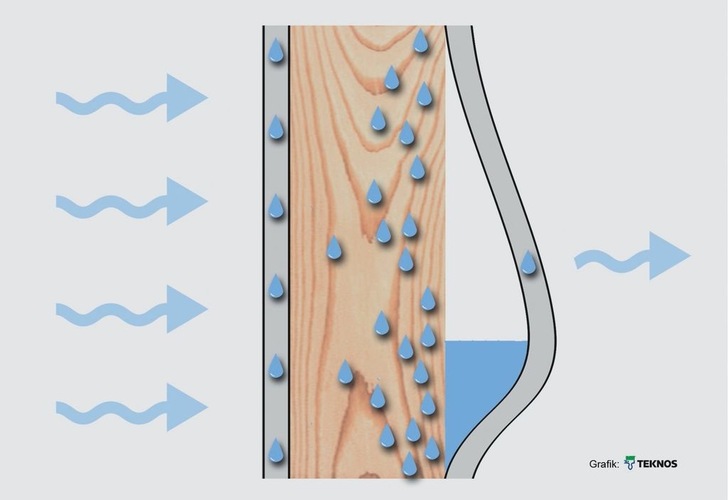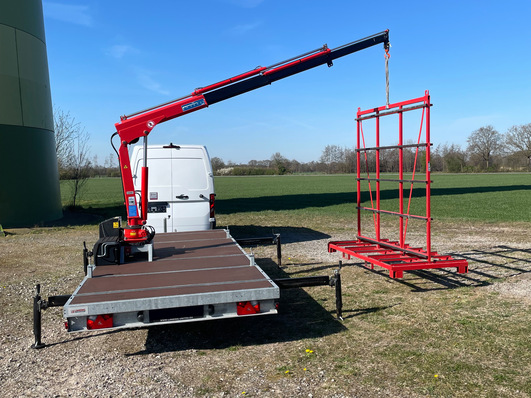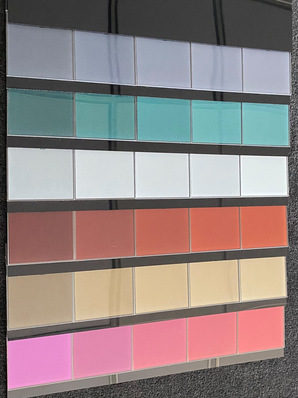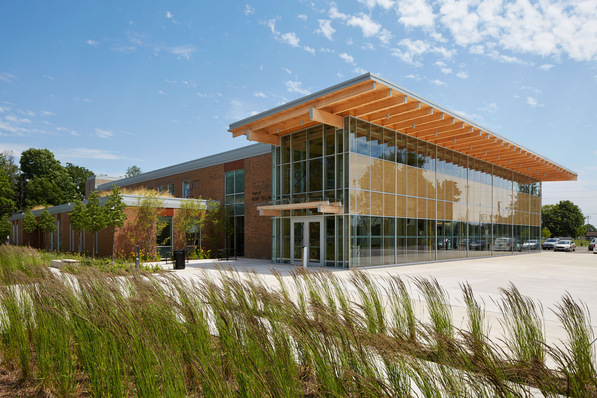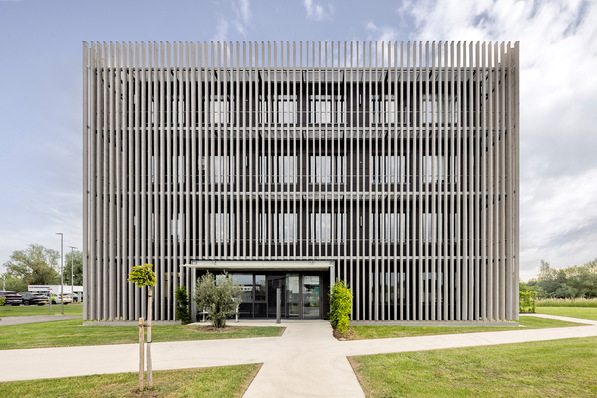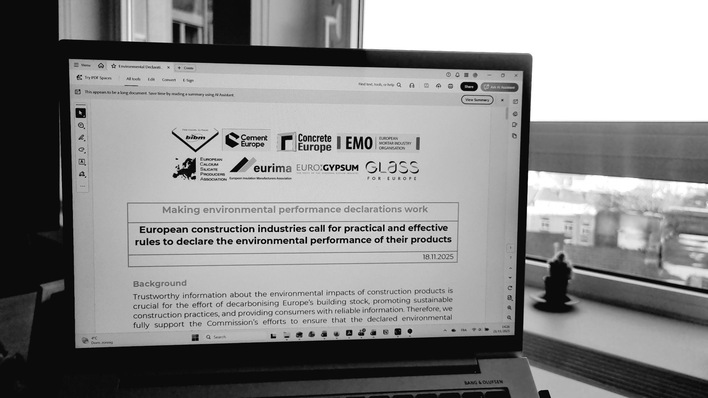"High building moisture loads at low outside temperatures can lead to considerable damage in the outer coating layer and the entire window construction under certain conditions," says Dr. Dirk Lukowsky from the Fraunhofer Institute for Wood Research WKI in Braunschweig. Paint damage often shows up a short time after installation of the construction elements in the form of round, sometimes extensively distributed blisters in the upper paint layer on the outside of the window. At first, the blisters are filled with water, later they dry up and leave behind a brittle, cracked surface.
The cause of the blister formation is a build-up of moisture in the window profile. Normally, the permeability of the paint film is sufficient to compensate for natural moisture fluctuations. However, if there is a particularly high humidity in the interior and the interior is also heated, a considerable water vapour pressure is created and large amounts of moisture penetrate the window profile from the inside. At the same time, when outside temperatures are low, the dew point is inside the frame profile, so the water vapour cannot evaporate sufficiently to the outside and water accumulates in the wood.
Moisture cannot escape
Sometimes the fibre saturation is actually exceeded; wood moisture contents of up to 30 per cent are not uncommon. With rising temperatures and sunlight from outside, the large amounts of water vapour in the wood profile cannot be released quickly enough through the varnish film, and the partially depleted varnish floats up and forms blisters.
Excessive condensation after plaster or screed work is also problematic. The water collects on the window sills, but also penetrates into the profile construction, where it freezes during heavy frost. Moisture-induced swelling can be recognised by the offset of the end grain and longitudinal wood edge in the sash corner area, but also by "bent" glazing beads.
[Wooden skyscrapers are a rising trend]
These unfavourable conditions, which are exacerbated by energy optimisation with increasingly tight building envelopes, occur especially in winter construction sites. When outside temperatures are low, attempts are usually made to bring about rapid drying by sealing and heating - especially after moisture-intensive screed and plaster work. However, this favours water vapour pressure and condensation, and in addition to the formation of bubbles in the paint, major damage can occur in the entire window construction, such as cracking of the profiles, screw cracks or even corrosion of the fittings. Depending on the room humidity and temperature conditions, the first damage to the paint can occur after only 24 hours.
Layer thickness matters
To prevent critical moisture build-up, the water vapour should be able to evaporate as well as possible from the inside to the outside through the window profile. The water vapour permeability depends first of all on the type of wood used - pine, for example, is more than three times as permeable as the giant evergreen Red Cedar. However, the coating also has a significant influence: with a dry layer thickness of 80 µm, the water vapour permeability is about 30-40 per cent lower than with uncoated wood of the same type.
[Mould in the window casing – here is what to do]
If, due to the coating, the water vapour permeability on the outside of the window is lower than on the inside, water vapour diffuses into the window profile faster than it diffuses out again. For this reason, the coating on the room side should have at least the same layer thickness as on the outside. For example, Teknos recommends a dry film thickness of 100 µm on the outside and also 100 µm on the inside of the windows for its opaque and glazing Gori coating systems for weathered wooden windows, in order to allow sufficient vapour diffusion through the material.
The ratio of the layer thicknesses must also be observed if the outside and inside are coated in different shades. Thus, an additional top coat applied to the outside of the windows can hinder vapour diffusion. The same also applies if maintenance coats are only applied on the outside, thus changing the ratio of the coating thicknesses.
Reduce construction-related moisture
Another point to consider is sufficient dehumidification. During the construction phase, particularly high moisture loads occur, which is further favoured by the rapid succession of different trades. The Association of Window and Facade Manufacturers (VFF) clearly points out the dangers of high construction moisture in its leaflet HO.08 (Measures for the Protection of Windows and External Doors during the Construction Phase) and makes clear recommendations. These include repeated daily shock ventilation, cross-ventilation, drawing up a ventilation plan for complex building projects and ensuring ventilation over holiday and public holiday rest periods.
[Windows in integral construction: Slim profiles, more daylight]
Particularly after the entry of high amounts of moisture, for example through plastering and screed work, the VFF recommends limiting the moisture load through ventilation or condensation drying to prevent damage to windows and exterior doors. The latter is particularly recommended if it is not possible to ventilate off the excess moisture, for example after screed work.
Conclusion
Manufacturers and installers should be aware of the particular risk of paint damage due to increased vapour pressure at winter construction sites. Damage can be easily avoided by proper coating and sufficient dehumidification. It would also be desirable that the previous trade-specific recommendations on drying and dehumidification on the construction site, which are partly contradictory, are coordinated into cross-trade recommendations with the participation of the various trade associations and expert committees.
Scientific background from Holzforschung Austria
Wooden windows are generally climate-separating building components, which are exposed to moisture through weathering and through the diffusion of moisture from the inside to the outside. The decisive factor is the gradient of the water vapour pressure between the interior and exterior climates. It depends on temperatures and the relative humidity inside and outside, which also determine the dew point. In the winter months, especially during the construction phase, extreme situations can occur when a lot of water vapour is introduced into the interior due to plastering and screed work and the room is heated and little or no ventilation is provided. The diffusion of water vapour through the frame cross-section of the wooden window can then lead to the formation of bubbles and adhesion problems of coatings on the outside of the window. Such extreme situations should always be avoided by sufficient ventilation; this also applies to increased humidity during subsequent use.
This article written by guest author Gerhard Grüll of Holzforschung Austria first appeared in our German sister publication GLASWELT.







